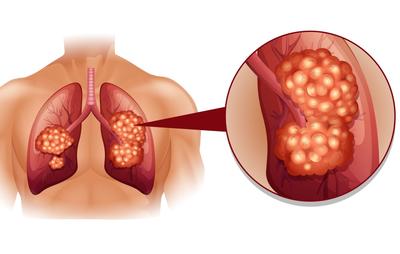
Diagnosed with Cancer? Your two greatest challenges are understanding cancer and understanding possible side effects from chemo and radiation. Knowledge is Power!
Learn about conventional, complementary, and integrative therapies.
Dealing with treatment side effects? Learn about evidence-based therapies to alleviate your symptoms.
Click the orange button to the right to learn more.
- You are here:
- Home »
- Blog »
- Lung Cancer »
- Lung Cancer- Mitigate Radiation Pneumonitis, Sensitize Tumor
Lung Cancer- Mitigate Radiation Pneumonitis, Sensitize Tumor

The results indicate that Lipo-cur can effectively mitigate Radiation Pneumonitis, reduce fibrosis, and sensitize lung cancer cells to irradiation
Lung cancer is an aggressive forms of cancer. Depending on your stage at diagnosis, conventional oncology is limited when it comes to average overall survival rates.
Therefore LC patients must use every evidence-based therapy tool possible to manage their cancer.
As the studies linked and excerpted below explain, pneumonitis can be a challenge for lung cancer patients undergoing radiation therapy.
I’ve worked with two lung cancer patients who underwent extensive radiation therapy for their inoperable lung cancer. Both developed extensive pneumonitis.
While this is a bit off-topic, I underwent several local radiation sessions (to manage specific myeloma lesions in my lower back. I began suffering from radiation-induce fibrosis after about five years.
My radiation scarring as continued to worsen. Managing or lessening radiation scarring is a critical goal for those cancer patients who have undergone local radiation.
Consider evidence-based integrative therapy to both reduce the risk of pneumonitis and/or sensitize lung cancer cells to radiation therapy enhancing the efficacy of this therapy.
I am a long-term survivor of an equally difficult but different cancer. I have managed my “incurable” cancer since 1994 by learning about and employing a spectrum of evidence-based therapies including curcumin.
Have you been diagnosed with lung cancer? If so, what stage? Are you considering undergoing radiation therapy? To learn more about evidence-based, non-conventional lung cancer therapies scroll down the page, post a comment or question and I will reply to you ASAP.
Thank you,
David Emerson
- Cancer Survivor
- Cancer Coach
- Director PeopleBeatingCancer
Recommended Reading:
- Early Lung Cancer Therapies Reduce Cancer Deaths Significantly
- Early Lung Cancer, SBRT if Surgery is Not an Option
- The Cure for Lung Cancer May Be in Fish Oil
- Fish Oil Improves Response to Chemo, Improves OS for Lung Cancer Patients
Pneumonitis
“Pneumonitis or pulmonitis is an inflammation of lung tissue.[1][2] Many factors can cause pneumonitis, including breathing in animal dander, aspiration (inhaling small food particles or vomit “down the wrong pipe”), and receiving radiation therapy to the chest.[3]..”
Adaptive radiotherapy reduces pneumonitis while controlling lung cancer
“Lung cancer patients who are treated with radiotherapy can develop an inflammation of the lung tissue called pneumonitis; this can limit the dose of radiation they can receive and severe forms of pneumonitis, if left untreated, can be fatal…
A systemic administration of liposomal curcumin inhibits radiation pneumonitis and sensitizes lung carcinoma to radiation
“Radiation pneumonitis (RP) is an important dose-limiting toxicity during thoracic radiotherapy. Previous investigations have shown that curcumin is used for the treatment of inflammatory conditions and cancer, suggesting that curcumin may prevent RP and sensitize cancer cells to irradiation. However, the clinical advancement of curcumin is limited by its poor water solubility and low bioavailability after oral administration…
Conclusion- In this study, a water-soluble Lipo-cur system was successfully developed. The results indicate that Lipo-cur can effectively mitigate RP, reduce the fibrosis of lung, and sensitize LL/2 cells to irradiation. This study also suggests that the systemic administration of Lipo-cur is safe and deserves to be investigated for further clinical application.”
Radiation Pneumonitis: Old Problem, New Tricks
“Radiation therapy is a major treatment modality for management of non-small cell lung cancer. Radiation pneumonitis is a dose limiting toxicity of radiotherapy, affecting its therapeutic ratio. This review presents patient and treatment related factors associated with the development of radiation pneumonitis. Research focusing on reducing the incidence of radiation pneumonitis by using information about lung ventilation, imaging-based biomarkers as well as normal tissue complication models is discussed. Recent advances in our understanding of molecular mechanisms underlying lung injury has led to the development of several targeted interventions, which are also explored in this review…
Conclusions
RP is a dose limiting toxicity of radiotherapy for management of NSCLC. The risk of development of RP as well as its severity is dependent on several patient and treatment related factors, including dosimetric factors and combining chemotherapy.
A recently published Bayesian randomized trial aimed at determining the benefit of protons for reduction of pulmonary toxicity had negative results. New frontiers for minimizing the incidence of RP are being explored. Information about heterogeneity in lung ventilation can be obtained from 4D CT scans and used to minimize dose to the well-ventilated lung.
Imaging-based biomarkers from PET scans can be used to identify patients at increased risk of pulmonary toxicity. NTCP models can also aid in risk stratification, patient selection and treatment planning. With advances in our understanding of molecular mechanisms underlying tissue injury, novel approaches for prevention and treatment of RP are on the horizon.”
Leave a Comment:
1 comment
[…] LC patients undergoing radiation face extensive collateral damage […]
Reply

